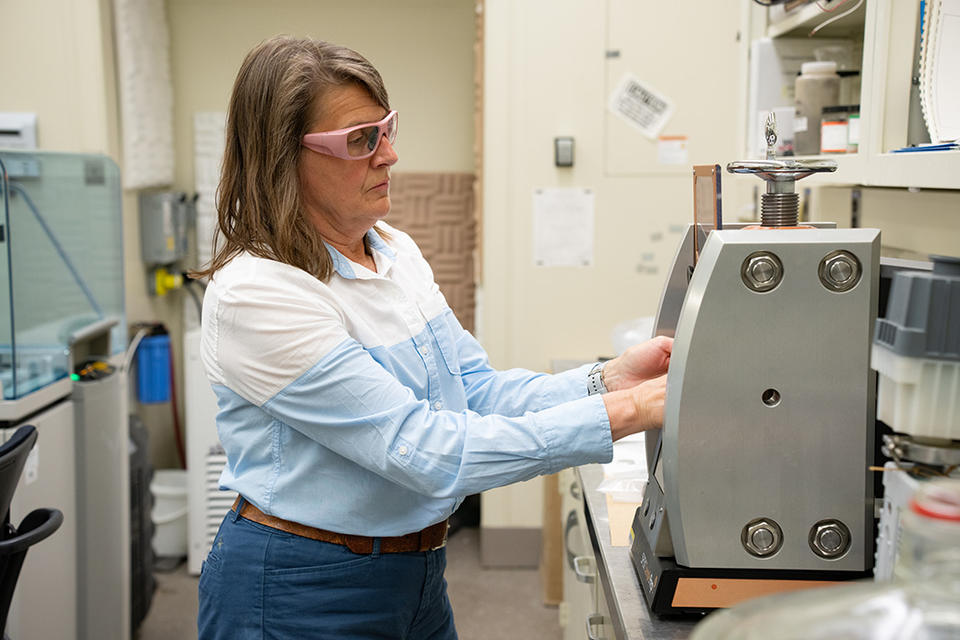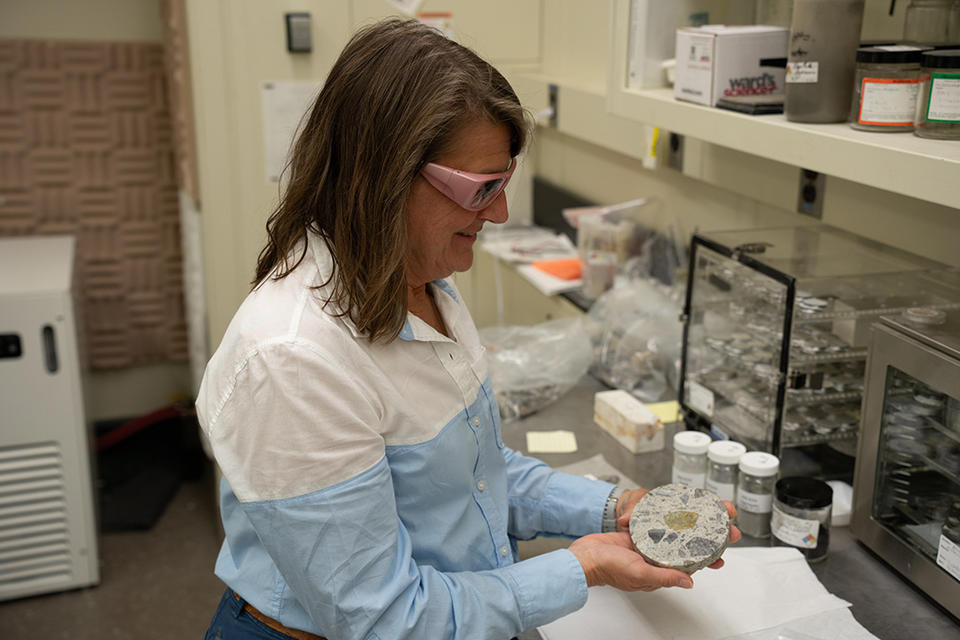Taking Measure
Just a Standard Blog

NIST researcher Stephanie Watson works in her lab.
Concrete is the second most used substance on Earth, bested only by water. It is so common that people tend to take it for granted, seeing it as gray, bland and boring.
But concrete isn’t boring at all. From towering Roman aqueducts to the sails of the Sydney Opera House, this “liquid rock” has flowed through human history and hardened into the literal foundations of modern society. And just because concrete is ancient doesn’t mean we aren’t still learning about it.
Researchers at NIST have studied concrete for more than 100 years. There are NIST experts on every aspect of concrete from the large scale of entire buildings, all the way down to the basic molecules and how they interact. This expertise makes NIST uniquely able to tackle scientific questions about concrete and its performance.
Some of our recent research has focused on unintentional chemical reactions that cause concrete to crack with disastrous results. We are just beginning to understand how these reactions work and what can be done to prevent them. Our concrete research has already saved billions for state governments, and we’re working to help homeowners address expensive cracks in their homes’ foundations.
What Actually Is Concrete?
Let’s start with the basics.
The basic recipe for concrete only has three ingredients: cement, water and little rocks.
Cement is the most complex of the three. It isn’t found in nature—cement has to be made by heating up limestone and clay to rock-melting temperatures. It’s then mixed with other minerals and ground down to a fine powder to make the final cement. This powder has an amazing chemical property: When you add water, it starts to harden.
Even though people say fresh cement is “wet” and hard cement is “dry,” the water never actually leaves. Hydrogen and oxygen from the water react with the cement powder to create new molecules of hard cement.
Rocks and sand can be added to the cement as a filler. This “aggregate” makes the final concrete cheaper and stronger than cement alone. Typically, 60%-80% of concrete is aggregate.

Cement, water, and little rocks. It sounds like a simple formula, but there are many ways for things to go wrong. The aggregate is particularly difficult to control. The rocks used for aggregate are almost always dug from quarries near the construction site, and they have many unintentional minerals in them. Usually, a variety of mineral compounds isn’t an issue, but sometimes it can start chemical reactions that cause concrete to crack. Concrete cancer is one of the most well-known of these reactions.
Concrete Cancer
The technical term for concrete cancer is the “alkali-silica reaction” or ASR. It happens when concrete containing a certain kind of aggregate stays moist for a long time.
Fresh cement is as caustic as bleach. It can chemically burn your skin if you don’t handle it carefully. In scientific terms, cement is very alkaline, the opposite of acidic. Once the cement hardens, it’s less potent and safe to touch. But if the hardened cement stays wet for a while, that moisture can leach ions from the cement and make very alkaline water in the little voids throughout the concrete. Some kinds of aggregate can react with this caustic water to form a clear, white or yellowish gel that absorbs water and slowly expands inside the concrete. That’s the start of concrete cancer.
The expanding gel presses outward. Hairline fractures spiderweb across the surface of the concrete. The area around the cracks sometimes takes on a yellow tint from the gel. Left unchecked, severe cases of concrete cancer could cause the structure to crumble apart.
“This is a slow process that takes years or even decades,” says Long Phan, a structural engineer who led the study. “But it gets worse over time, and the damage is irreversible.”
Scientists have known about concrete cancer since the 1950s, but it wasn’t well studied. No one knew whether these cracks were immediately dangerous or just ugly.
In 2009, experts urgently needed to answer that question. The Seabrook Station Nuclear Power Plant, which is the largest single source of power in New England, showed early signs of concrete cancer. The Nuclear Regulatory Commission (NRC) wanted to know whether the plant was safe and what could be done to slow the reaction. They asked NIST to study the phenomenon.
Over the next several years, NIST recreated concrete cancer in the lab. Researchers built large samples of concrete and intentionally poisoned those samples with the right kind of aggregate to cause ASR. Then, by keeping the samples in a special room at about 24 degrees Celsius (75 degrees Fahrenheit) and 95% humidity, they sped up the chemical reaction, so it would happen over the course of months, rather than years. They then squeezed and stretched the infected samples with large hydraulic presses to see how different amounts of ASR affect the strength of the concrete.
Thanks in large part to NIST research, the NRC determined that the ASR would not cause any issues if the moisture at Seabrook was carefully managed. The NRC recertified the power plant for another 20 years of service. Continuing to operate for just 10 more years will lead to more than $2 billion of savings for Massachusetts alone in electricity costs and economic activity.
The Pyrrhotite Problem
Starting around 2015, thousands of homeowners in Connecticut began finding cracks in the foundations of their homes. Trace amounts of a mineral called pyrrhotite [pronounced pyr·rho·tite] caused the cracks decades after the houses were built. In many homes, these cracks were ruinous. The only way to fix them is to lift the entire house up with jacks, tear out the old concrete, and re-pour the entire foundation.
Thousands of homes and other structures in the surrounding areas were also found have this issue, and replacing a foundation sometimes costs more than the total value of the house it sits on.
Pyrrhotite is a mineral made of iron and sulfur. In the presence of water, it dissolves into iron ions and sulfuric acid. Both chemicals are bad for concrete. The iron becomes a solid that is slightly larger than it was before, pushing out on the concrete. The sulfuric acid can start what concrete researchers call a “sulfate attack.” This creates more expanding solids inside the concrete and eats away at the cement holding the concrete together.
NIST research led by Stephanie Watson is reducing the impacts of pyrrhotite by finding effective ways to detect it.

“Detecting pyrrhotite is really tricky,” explained Watson. “We had to try a few different approaches. We tried burning samples, digesting them with chemicals, embedding them in glass and passing X-rays through them. But each method found a different amount of pyrrhotite for the same sample.”
Part of the challenge is that they’re looking for a tiny concentration, a fraction of 1%.
“We still don’t know the minimum level of pyrrhotite needed to start the reaction,” said Watson.
Watson’s team decided the best approach for detecting the mineral is a process called X-ray fluorescence. An X-ray fluorescence machine hits a sample with X-rays. The atoms in the sample absorb some of that energy and then release it as new X-rays at a different frequency. Every atom releases a unique pattern of X-rays. It’s sort of like a barcode scanner for atoms.
But for X-ray fluorescence to work, they need standardized samples of concrete laced with pyrrhotite to calibrate the machines.
To create their reference material, Watson’s team pioneered a method to make pure pyrrhotite in the lab. After many months of trial and error, they discovered that they could force the mineral to form by putting iron and sulfur together in a glass vial, sucking all oxygen out, and then heating it up to extreme temperatures in a tube furnace.
The reference material has four components: cement, aggregate, sand and pure pyrrhotite to mimic the composition of concrete samples from homes with pyrrhotite damage. This reference material is in the final stages of development and will soon be available for others to use.
It will allow researchers and companies to run a straightforward test to see if pyrrhotite is in the different ingredients used to make concrete before it is poured. It will also allow homeowners to request that their local government test for pyrrhotite in their homes’ existing foundations. There is currently no known fix for pyrrhotite in hardened cement, though in the future, Watson and her team plan to test treatments that might work, such as applying a moisture-resistant coating.
“It’s a big challenge to link the microscopic scale of chemistry all the way up to the structural scale of an entire house,” she says. “But this research will have a big impact on thousands of current and future homes.”





